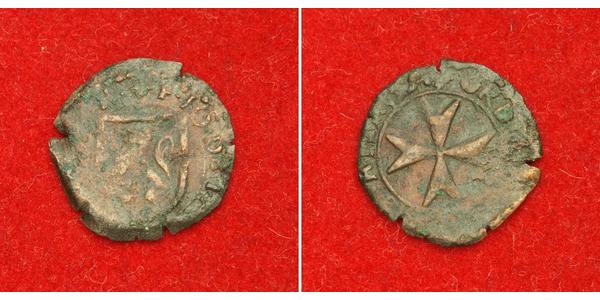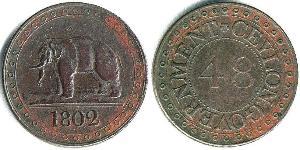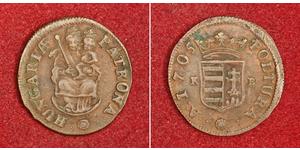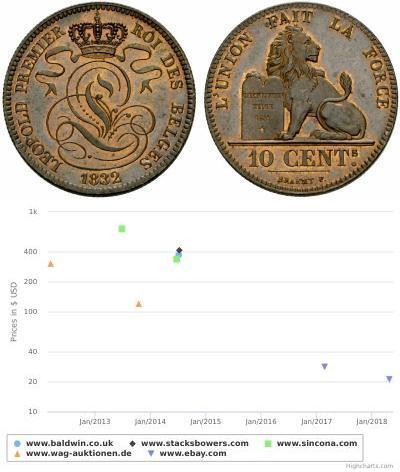(продана за $82.0)
1572, Knights of Malta, Jean de Levesque de la Cassiere. Copper Picciolo (Diniere) Coin. F+
Condition: F+
Mint Place: Valetta
Mint Period: 1572-1581
Reference: Restelli 27. R!
Denomination: Picciolo (Diniere)
Material: Copper
Diameter: 15mm
Weight: 0.53gm
Obverse: Shield with arms of the Grand Master. Legend around.
Reverse: Maltese cross within inner circle. Legend around.
Fra' Jean l'Evesque de la Cassière (1502 – 21 December 1581) was the 51st Grand Master of the Order of Malta, from 1572 to 1581. He commissioned the building of the Conventual Church of the Order (St John's Co-Cathedral) in Valletta, Malta, and is buried in the Crypt of St. John.
La Cassiere had earned acclaim for his bravery in the battle of Zoara in Northern Africa where he had saved the colors of the Order. He was Grand Prior of the Order’s Langue d’Auvergne when he was elected on 30 January 1572 to succeed Pierre de Monte as Grandmaster.
The early years of his reign as Grand Master were marked by numerous disputes and quarrels between the Order and the Bishop of Malta over the ecclesiastical jurisdiction of the bishop. These disputes were unprecedented in the history of the Order since it had arrived in Malta in 1530 with a grant of virtual sovereignty from Emperor Charles V. La Cassiere was unable to resolve the matter, which finally was submitted to Pope Gregory XIII who in turn appointed a Grand Inquisitor, a step that caused enormous resentment within the Order.
A second major conflict arose in 1575 with the Republic of Venice, when Maltese galleys seized a Venetian ship that carried goods for Jewish owners. Venice was outraged, and the Order soon faced the threat of having all of its property on Venetian territory confiscated. Again it required the intervention of the Pope, as well as the payment by La Cassiere of complete compensation, to resolve the dispute. And again, there was much discontent among the knights over this perceived rebuke to their assumed right to confiscate any property of non-Christians.
The third and most serious cause of discord within the Order during La Cassiere’s rule was triggered by King Philip II of Spain who managed to arrange the appointment of one of his close relatives, 17-year-old Archduke Wenzel (Wenceslaus) of Austria (son of Emperor Maximilan II, Philip’s cousin), to the Grand Priory of Castile and Leon and the Bailiwick of Lora. Outraged by the king’s interference, the Castilian knights of the Order openly rebelled against this appointment. In response, the Pope ordered them to apologize publicly before the Grand Master and the General Convent for this insubordination.
These events further fuelled resentment within the Order and the General Convent against La Cassiere, who was widely perceived to be the cause of these problems and humiliations. It eventually broke into virtual mutiny on 11 July 1581, when the Convent deposed La Cassiere and placed him in confinement in Fort St. Angelo. This meant that Mathurin Romegas, former Grand Prior of Toulouse and the Order’s most celebrated naval hero, who had been elected Lieutenant to the Grand Master in 1577, was now the de facto Grand Master.
The Pope immediately sent a special envoy, Gaspare Visconti, to investigate and, simultaneously, to administer the Order until the dispute could be settled. La Cassiere and Romegas were both summoned to Rome to explain their conduct and plead their case. La Cassiere arrived in Rome on 26 October 1581 and, on orders of Pope Gregory XIII, was treated with much deference and ceremony. By contrast, Romegas was treated with extreme coldness and much disdain. He died, alone and with broken spirit, within a week, on 4 November 1581. La Cassiere was honorably acquitted of all charges against him and restored to the position of Grand Master. He did not live long enough, however, to enjoy his triumph, dying in Rome on 21 December 1581 at the age of seventy-eight. His body was transferred to Malta and buried in St. John's Co-Cathedral in Valletta.
The Knights Hospitaller (also known as the Sovereign Military Hospitaller Order of St. John of Jerusalem of Rhodes and of Malta, Order of St. John, Knights of Malta, and Chevaliers of Malta; French: Ordre des Hospitaliers, Maltese: Ordni ta' San Gwann) was a Christian organization that began as an Amalfitan hospital founded in Jerusalem in 1080 to provide care for poor, sick or injured pilgrims to the Holy Land. After the Western Christian reconquest of Jerusalem in 1099 during the First Crusade it became a religious/military order under its own charter, and was charged with the care and defense of the Holy Land. Following the conquest of the Holy Land by Islamic forces, the Order operated from Rhodes, over which it was sovereign, and later from Malta where it administered a vassal state under the Spanish viceroy of Sicily.
The Order lost many of its European holdings following the rise of Protestantism and French Egalitarianism, but survived on Malta. The property of the English branch was confiscated in 1540. In 1577, the German Bailiwick of Brandenburg became Lutheran, but continued to pay its financial contribution to the Order until the branch was turned into a merit Order by the King of Prussia in 1812. The "Johanniter Orden" was restored as a Prussian Order of Knights Hospitaller in 1852.
The Knights of Malta had a strong presence within the Imperial Russian Navy and the pre-revolutionary French Navy. When De Poincy was appointed governor of the French colony on St. Kitts in 1639 he was a prominent Knight of St. John and dressed his retinue with the emblems of the Order. In 1651, the Knights bought from the Compagnie des Îles de l'Amérique the islands of Sainte-Christophe, Saint Martin, and Saint Barthélemy. The Order's presence in the Caribbean was eclipsed with De Poincy's death in 1660. He had also bought the island of Saint Croix as his personal estate and deeded it to the Knights of St. John. In 1665, the order sold their Caribbean possessions to the French West India Company, ending the Order's presence in that region.
The decree of the French National Assembly Abolishing the Feudal System (1789) abolished the Order in France: V. Tithes of every description, as well as the dues which have been substituted for them, under whatever denomination they are known or collected (even when compounded for), possessed by secular or regular congregations, by holders of benefices, members of corporations (including the Order of Malta and other religious and military orders), as well as those devoted to the maintenance of churches, those impropriated to lay persons and those substituted for the portion congrue, are abolished (...) (The Decree Abolishing the Feudal System, August 11, 1789, J.H. Robinson, ed., Readings in European History 2 vols. (Boston: Ginn, 1906), 2: 404-409) The French Revolutionary Government seized the assets and properties of the Order in France in 1792.
Only 1$ shipping for each additional coin purchased!

|
Добавив:
anonymous 2016-07-11 |






















